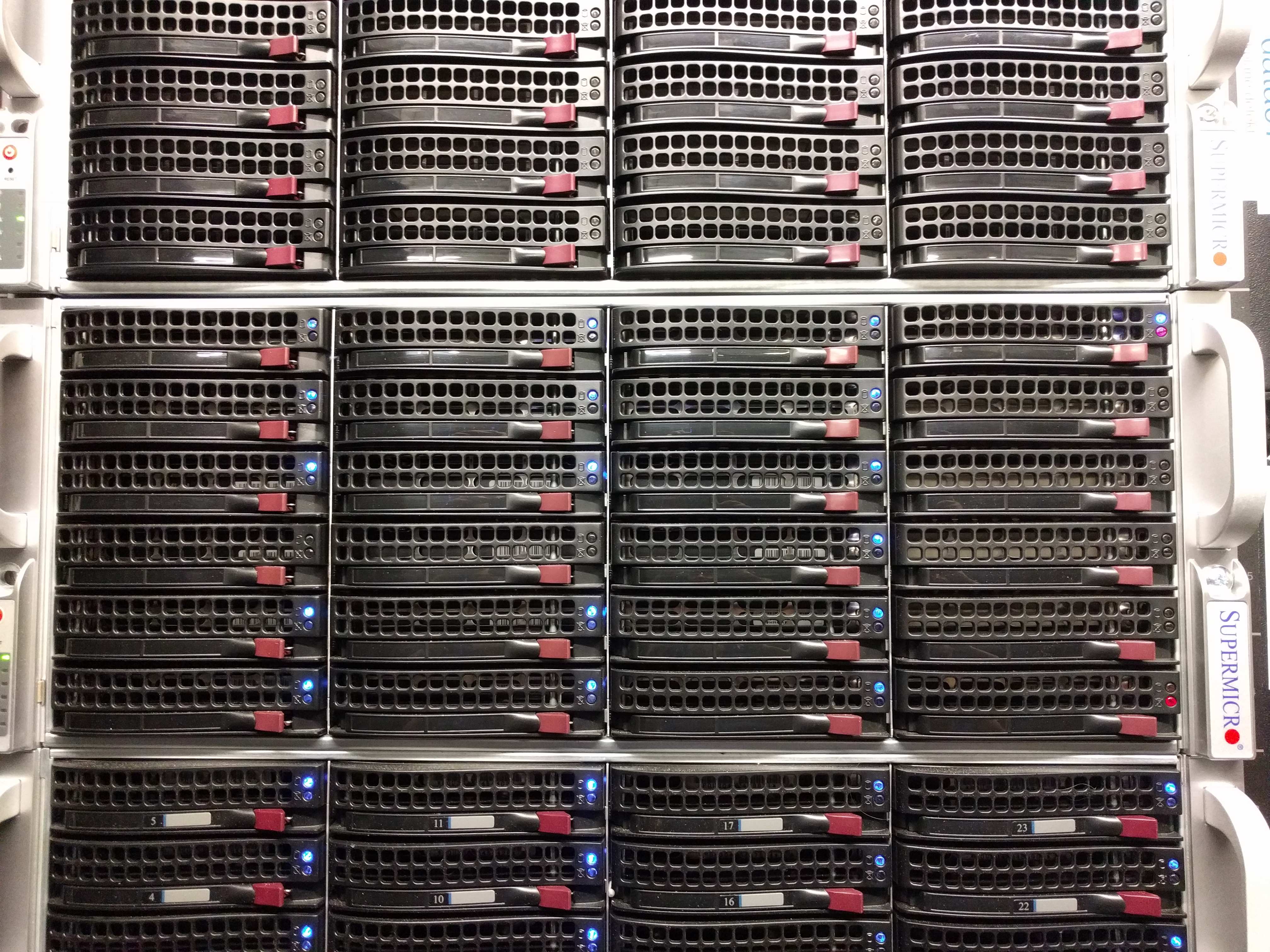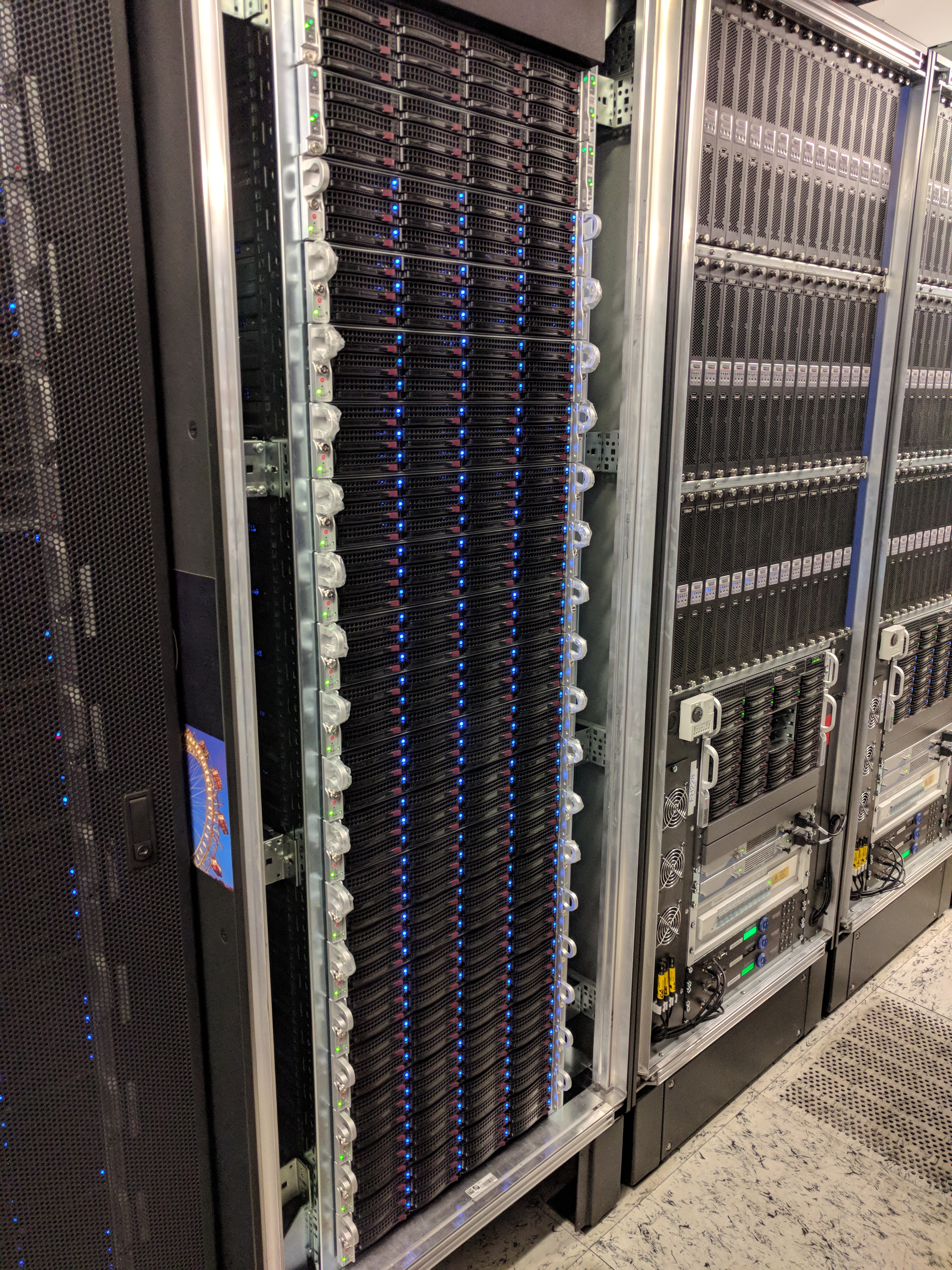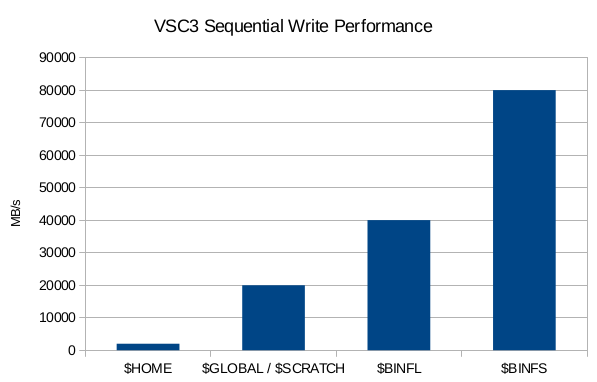Table of Contents
Storage Infrastructure of VSC2 and VSC3
- Motivation
- Know how a HPC storage stack can be integrated into a supercomputer
- and gain some additional insights
- Know the hard- and software to harness its full potential
VSC2 - Basic Infos
- VSC2
- Procured in 2011
- Installed by MEGWARE
- 1314 Compute Nodes
- 2 CPUs each (AMD Opteron 6132 HE, 2.2Ghz)
- 32 GB RAM
- 2x Gigabit Ethernet
- 1x Infiniband QDR
- Login Nodes, Head Nodes, Hypervisors, etc…
VSC2 - File Systems
- File Systems on VSC2
- User Homes (/home/lvXXXXX)
- Global (/fhgfs)
- Scratch (/fhgfs/nodeName)
- TMP (/tmp)
- Change Filesystem with ‘cd’
- cd /global # Go into Global
- cd ~ # Go into Home
- Use your applications settings to set in/out directories
- Pipe the output into your home with ‘./myApp.sh 2>&1 > ~/out.txt’
VSC - Fileserver
VSC - Why different Filesystems
- Home File Systems
- BeegFS (FhGFS) was very slow when it came to small file I/O
- Leads to severe slowdown when compiling applications and/or
- working with small files in general
- We do not recommend using small files. Use big files when possible, however users want to
- Compile Programs
- Do some testing
- Write (small) Log Files
- etc…
VSC - Why different Filesystems
- Global
- Parallell Filesystem (BeeGFS)
- Perfectly suited for large sequential transfers
- TMP
- Uses the main memory (RAM) of the server. Up to 1/2 size of the whole memory.
- Users can access it like a file system but they get the speed of a byte-wise addressable storage
- Random I/O is blindingly fast
- But comes at the price of main memory
- If you are not sure how to map your file from GLOBAL/HOME into memory just copy it to TMP and you are ready to go
VSC - Why different Filesystems
- Small I/Os
- Random Access –> TMP
- Others –> HOME
- Large I/Os
- Random Access –> TMP
- Sequential Access –> GLOBAL
VSC2 - Storage Homes
- VSC2 - Homes
- 6 File Servers for Home
- 2 CPUs each (Intel Xeon E5620 @ 2.40 Ghz - Westmere)
- 48 GB RAM
- 1x Infiniband QDR
- LSI Raid Controller
- Homes are Stored on RAID6 Volumes
- 10+2 Disks per Array. Up to 3 Arrays per Server (Depends on usage)
- Exported via NFS to the compute nodes (No RDMA)
- Each project resides on 1 server
VSC2 - Storage Global
- VSC2 - Global
- 8 File Servers
- 2 CPUs each (Intel Xeon E5620 @ 2.40 Ghz - Westmere)
- 192 GB RAM
- 1x Infiniband QDR
- LSI Raid Controller
- OSTs consist of 24 Disks (22+1p+1Hot-Spare RAID5)
- One Metadata Target per Server
- 4x Intel X25-E 64 GB SSDs
- Up to 6000 MB/s throughput
- ~ 160 TB capacity
VSC2 - Storage Summary
- 14 Servers
- ~ 400 spinning disks
- ~ 25 SSDs
- 2 Filesystems (Home+Global)
- 1 Temporary Filesystem
VSC3 - Basic Infos
- Procured in 2014
- Installed by CLUSTERVISION
- 2020 Nodes
- 2 CPUs each (Intel Xeon E5-2650 v2 @ 2.60 Ghz)
- 64 GB RAM
- 2x Infiniband QDR (Dual-Rail)
- 2x Gigabit Ethernet
- Login Nodes, Head Nodes, Hypervisors, Accelerator Nodes, etc…
VSC3 - File Systems
- User Homes (/home/lvXXXXX)
- Global (/global)
- Scratch (/scratch)
- EODC-GPFS (/eodc)
- BINFS (/binfs)
- BINFL (/binfl)
VSC3 - Home File System
- VSC3 - Homes
- 9 Servers (Intel Xeon E5620 @ 2.40 Ghz)
- 64 GB RAM
- 1x Infiniband QDR
- LSI Raid Controller
- Homes are stored on RAID6 Volumes
- 10+2 Disks per Array. Up to 3 Arrays per Server (Depends on usage)
- Exported via NFS to the compute nodes (No RDMA)
- 1 Server without RAID Controller running ZFS
- Quotas are enforced
VSC3 - Global File System
- VSC3 - Global
- 8 Servers (Intel Xeon E5-1620 v2 @ 3.70 Ghz)
- 128 GB RAM
- 1x Infiniband QDR
- LSI Raid Controller
- 4 OSTs per Server
- 48 Disk 4x(10+2p)
- 1 Metadata Target per Server
- 2 SSDs each (Raid-1 / Mirrored)
- Up to 20’000 MB/s throughput
- ~ 600 TB capacity
VSC3 - GPFS
- IBM GPFS - General Parallell Filesystem / Elastic Storage / Spectrum Scale
- Released in 1998 as multi media filesystem (mmfs)
- Linux support since 1999
- Has been in use on many supercomputers
- Separate Storage Pools
- CES - Cluster Export Services
- Can be linked to a hadoop cluster
- Supports
- Striping
- n-way Replication
- Raid (Spectrum Scale Raid)
- Fast rebuild
- …
VSC3 - EODC Filesystem
- VSC3 <–> EODC
- 4 IBM ESS Servers (~350 spinning disks each)
- Running GPFS 4.2.3
- 12 Infiniband QDR Links
- Up to 14 GB/s sequential write and 26 GB sequential read
- Multi tiered (IBM HSM)
- Least recently used files are written to tape
- Stub File stays in the file system
- Transparent recall after access
- Support for schedules, callbacks, Migration Control, etc.
- Sentinel Satellite Data
- Multiple petabytes
- Needs backup on different locations
VSC3 - EODC Filesystem
- VSC3 is a “remote cluster” for the EODC GPFS filesystem
- 2 Management servers
- Tie-Breaker disk for quorum
- No filesystems (only remote filesystems from EODC)
- Up to 500 VSC clients can use GPFS in parallell
VSC3 - Bioinformatics
- VSC3 got a “bioinformatics” upgrade in late 2016
- 17 Nodes
- 2x Intel Xeon E5-2690 v4 @ 2.60 Ghz (14 cores each / 28 with hyperthreading)
- Each node has at least 512 GB RAM
- 1x Infiniband QDR (40 Gbit/s)
- 1x Omnipath (100 Gbit/s)
- 12 spinning disks
- 4 NVMe Memories (Intel DC P3600)
- These Nodes export 2 filesystems to VSC (BINFL and BINFS)
VSC3 - Bioinformatics
VSC3 - BINFL Filesystem
- Use for I/O intensive bioinformatics jobs
- ~ 1 PB Space (Quotas enforced)
- BeeGFS Filesystem
- Metadata Servers
- Metadata on Datacenter SSDs (RAID-10)
- 8 Metadata Servers
- Object Storages
- Disk Storages configured as RAID-6
- 12 Disks per Target / 1 Target per Server / 16 Servers total
- Up to 40 Gigabyte/second write speed
Binfs
- Use for very I/O intensive jobs
- ~ 100 TB Space (Quotas enforced)
- BeeGFS Filesystem
- Metadata Servers
- Metadata on Datacenter SSDs (RAID-10)
- 8 Metadata Servers
- Object Storages
- Datacenter SSDs are used insteand of traditional disks.
- No redundancy. See it as (very) fast and low-latency scratch space. Data may be lost after a hardware failure.
- 4x Intel P3600 2TB Datacenter SSDs per Server
- 16 Storage Servers
- Up to 80 Gigabyte/second via OmniPath Interconnect
VSC3 - Storage Summary
- 33 Servers
- ~ 800 spinning disks
- ~ 100 SSDs
- 5 Filesystems (
- Home
- Global
- EODC
- BINFS
- BINFL
- Temporary Filesystem
Storage Performance
Temporary Filesystems
- Use for
- Random I/O
- Many small files
- Data gets deleted after the job
- Write Results to $HOME or $GLOBAL
- Disadvantages
- Disk space is consumed from main memory
- Alternatively the mmap() system call can be used
- Keep in mind, that mmap() uses lazy loading
- Very small files waste main memory (memory mapped files are aligned to page-size)
Addendum: Backup
- Only for disaster recovery we keep some backups
- Systems (Node Images, Head Nodes, Hypervisors, VMs, Module Environment)
- via rsnapshot
- Home
- Home filesystems are backupped
- via self written, parallellized rsync script
- Global
- Metadata is backupped. But if a total disaster happens this won’t help.
- Altough nothing happenend for some time, this is high performance computing and redundancy is minimal
- Keep an eye on your data. If it’s important you should backup it yourself.
- Use rsync
Addendum: Big Files
- What does an administrator mean with ‘don’t use small files’?
- It depends
- On /global fopen –> fclose takes ~100 microseconds
- On VSC2 Home Filesystems > 100 Million Files are stored.
- A check which files have changed takes more than 12 hours. Without even reading file contents or copying.
- What we mean is: Use reasonable file sizes according to your working set and your throughput needs
- Reading a 2 GB File from SSD takes less than one second. Having files which are a few MB in size, will slow down your processing.
- If you need high throughput with your >1TB working set a file size >=10E8 bytes is reasonable
- File Sizes < 10E6 bytes are problematic if you plan to use many files
- If you want to do random i/o copy your files to TMP.
- Storage works well when the blocksize is reasonable for the storage system (on VSC3 a few Megabytes are enough)
- Do not create millions of files
- If every user had millions of files we’d run into some problems
- Use ‘tar’ to archive unneeded files
- tar -cvpf myArchive.tar myFolderWithFiles/
- tar -cvjpf myArchive.tar myFolderWithFiles/ # Uses bzip2 compression
- Extract with
- tar xf myArchive.tar
The End
Thank you for your attention


